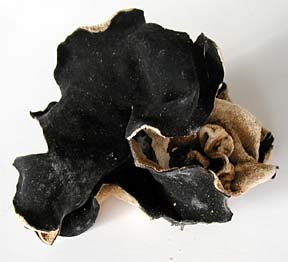
Eleanor Nakama-Mitsunaga
![]()
|
Judging it by name and appearance, black fungus isn't something one would immediately gravitate toward. But for the Chinese this centuries-old ingredient symbolizes longevity.
The basics: Black fungus, also called wood ear or tree ear fungus because its shape resembles a human ear, is similar to mushrooms. In China, where it is called fungi ha mok yi, it has been cultivated for centuries, first used medicinally as a blood thinner and to prevent hemorrhages.
Black fungus grows on rotting oak, mulberry, elm and willow trees. In China, wood from these trees is cut into poles and soaked in water for months, then piled and allowed to rot naturally on the ground. It takes a couple of years for the fungus spores to grow over them.
The fungus is dried immediately after harvest. It is black on one side and fuzzy and grayish on the other, with a shriveled appearance. Rather than its taste, the fungus is prized for its texture and the way its color contrasts with other ingredients.
A rarer, cream-colored variety is referred to as cloud ear fungus.
Black fungus is said to be rich in protein, calcium and iron.
Selecting: Black fungus is generally sold dried in bags of 4 to 8 ounces. The size of the fungus varies -- generally, the larger the product, the tougher it is.
Storing: If kept in a dry, dark area in an airtight container, black fungus will last indefinitely. After soaking, it should be refrigerated and will keep four to five days.
Use: Dried black fungus needs to be soaked in warm or boiling water for about 30 minutes, then rinsed thoroughly. The hard stems may need to be cut off on some pieces. Remember, as it is a dried product with concentrated flavor, a little goes a long way.
Many Chinese recipes call for cutting the fungus into long, thin strips. It is most commonly used in jai, hot and sour soup and mu shu pork, but can also be added to stir-fries and salads.
The Japanese call the fungus kikurage and use it in stir-fried dishes with other mountain and root vegetables such as bamboo shoots. It is also used in making tempura.
Where to buy: Black fungus is available at most Asian markets and in Chinatown. Prices are inexpensive at $1 to $2, depending on quantity.
Eleanor Nakama-Mitsunaga is
a free-lance food writer. Contact her
online through features@starbulletin.com


